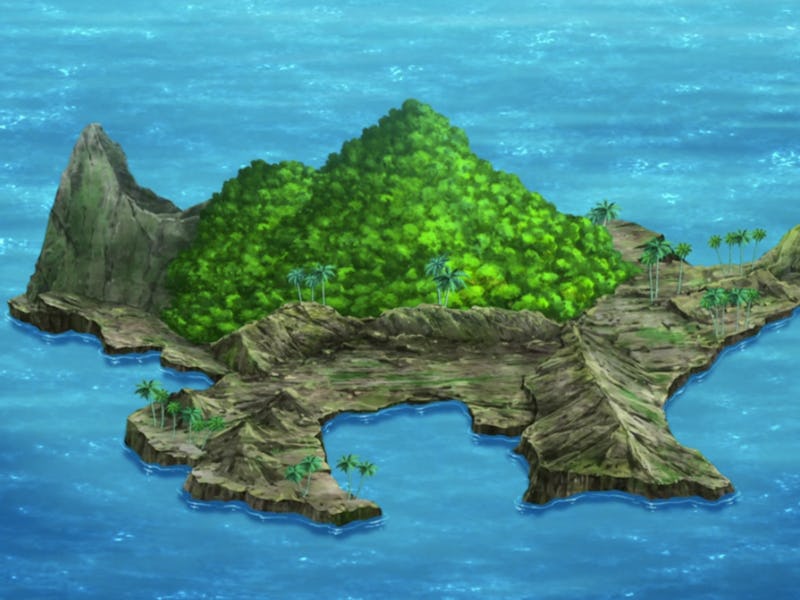Who Doesn’t Love a Mysterious Pokémon Island?
The Sevii Islands are still a shining example of this bizarre franchise tradition.

The original Pokémon game featured an intriguing mystery. On the already spooky Cinnabar Island, players could encounter an unofficial Pokémon called MissingNo by riding a water-type Pokémon up and down the eastern shore of the island. MissingNo was a glitch in the Pokémon Red and Blue — and a key part of the game’s iconic item duplication glitch — but it also introduced a concept that would return to the game almost a decade later: the mysterious island.
Released on January 29, 2004, Pokémon FireRed and Pokémon LeafGreen were the first remakes in what has become a tradition for the long-running franchise. However, these initial outings offered a location that was never seen in the original Red and Green games: the Sevii Islands. It’s a place that both reminded fans of the anime, offered some fun new details to the franchise, and remains a little bit befuddling to this day.
Next stop, the Sevii Islands!
The Sevii Islands are a series of nine islands the player can explore after defeating gym leader Blaine and earning the Volcano Badge on Cinnabar Island. Well, the first three islands anyway. Discovering them fully is a staggered system, as Four Island, Five Island, Six Island, and Seven Island are only available after one has the Rainbow Pass, which is obtained by nabbing a specific item. After that, you can get the Aurora Ticket and Mystic Ticket, which allow access to Navel Rock and Birth Island. It sounds a bit complicated, but it’s only the tip of the iceberg.
That’s not to say that it wasn’t exciting to find back when the games were released in 2004. For fans of the wider franchise, escaping the familiar world of the Kanto region and traveling to an adjacent collection of islands is reminiscent of the Orange Islands arc in the anime. Ash Ketchum visited it after his defeat in the Indigo League, and it was the place where he won his first championship. (Sadly, this didn’t garner the kind of headlines that his most recent championship wins did, but we’ll let that slide.)
In real life, the arc was constructed to buy the producers of the Pokémon anime some time while the video game developer finished Gold and Silver. It’s what some anime fans would consider to be a “filler arc.” (Even though Ash did win a championship there! Pikachu beat a really tough Dragonite and everything. Nevermind. Can’t let it go.)
Ash became a Pokémon champion on the Sevii Islands.
So the Sevii Islands provided a sense of nostalgia for an entirely separate thing, but they also lent new details to the game’s world. They introduced Mt. Ember, a dormant volcano that's home to the legendary bird Moltres. In Red and Green, the Ice-type Articuno lived in the chilly Seafoam Islands, while the Electric-type Zapdos lurked in the back of the Power Plant. Moltres seemed to be placed at random in the Victory Road cave. Putting the Fire-type legendary in a place called Mt. Ember was much more fitting.
And it’s in Mt. Ember that the Sevii Islands’ true purpose is revealed: an extended introduction to being able to trade with the “Generation III” Pokémon games set in the Hoenn region like Ruby, Sapphire and Emerald. This requires gathering items called the Ruby (found in Mt. Ember, which grants you the aforementioned Rainbow Pass) and the Sapphire (found after a belabored plotline with Team Rocket, one that ends when they realize that their leader Giovanni has been manhandled by a ten-year-old and skedaddle.) When combined and given to another character, one can finally make those trades. It’s a lot of fetch work, but at least it gives you something to do after completing the main game.
That “something to do” ends there, however, because if you were playing FireRed and LeafGreen on a Game Boy Advance in 2024, your adventure would come to an anticlimactic halt. To get to Navel Rock (where you can try to capture the Legendary Pokémon Ho-Oh and Lugia, you need a Mystic Ticket). And to get to Birth Island and a potential battle with Deoxys, you need an Aurora Ticket. But due to these items being given out in Mystery Gift events, which demanded your physical presence at a Nintendo store or convention center, they’ve both been inaccessible for over fifteen years now. Pokémon Emerald, which also allows you to visit these final two islands, also necessitates that you leap these hurdles.
The Sevii Islands gave Moltres a proper home.
So are the Sevii Islands a curiosity or a chore? Honestly, a little of both. The Pokémon franchise is no stranger to the fetch quest — it’s a staple of the wider RPG genre (and video games in general) to block paths and restrict entryways until the player returns with a new item or ability. Having a post-game and a refreshing new location for a classic monster is always fun, however, much of it is devoted to trading with other games. And the unnecessary complexities involved in this pale in comparison to the next set of remakes, the widely praised HeartGold and SoulSilver, which allow you to trade with other ”Generation IV” titles pretty much from the beginning.
Pokémon FireRed and LeafGreen are very competent remakes, but the fate of the Sevii Islands is a little more unclear. Part nostalgia trip, part new journey, and part exhausting sidequest, whether they ignite the spirit of adventure or cause the power switch to come crashing down is up to the player. And it all makes for one of the oddest sections of any game in the franchise.